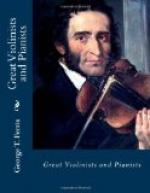I.
The life of Olaus Bull, or Ole Bull, as he is generally known to the world, was not only of much interest in its relation to music, but singularly full of vicissitude and adventure. He was born at Bergen, Norway, February 5, 1810, of one of the leading families of that resort of shippers, timber-dealers, and fishermen. His father, John Storm Bull, was a pharmaceutist, and among his ancestors he numbered the Norwegian poet Edward Storm, author of the “Sinclair Lay,” an epic on the fate of Colonel Sinclair, who with a thousand Hebridean and Scotch pirates, made a descent on the Norwegian coast, thus emulating the Vikingr forefathers of the Norwegians themselves. The peasants slew them to a man by rolling rocks down on them from the fearful pass of the Gulbrands Dahl, and the event has been celebrated both by the poet’s lay and the painter’s brush. By the mother’s side Ole Bull came of excellent Dutch stock, three of his uncles being captains in the army and navy, and another a journalist of repute. A passion for music was inherent in the family, and the editor had occasional quartet parties at his house, where the works of Haydn, Mozart, and Beethoven were given, much to the delight of young Ole, who was often present at these festive occasions.
The romantic and ardent imagination of the boy was fed by the weird legends familiar to every Norwegian nursery. The Scheherezade of this occasion was the boy’s own grandmother, who told him with hushed breath the fairy folk-lore of the mysterious Huldra and the Fossikal, or Spirit of the Waterfall, and Ole Bull, with his passion for music, was wont to fancy that the music of the rushing waters was the singing of the violins played by fairy artists. From an early age this Greek passion for personifying all the sights and sounds of nature manifested itself noticeably, but always in some way connected with music. He would fancy even that he could hear the bluebells and violets singing, and perfume and color translated themselves into analogies of sound. This poetic imagination grew with his years and widened with his experience, becoming the cardinal motive of Ole Bull’s art life. For a long time the young boy had longed for a violin of his own, and finally his uncle who gave the musical parties presented him with a violin. Ole worked so hard in practicing on his new treasure that he was soon able to take part in the little concerts.




